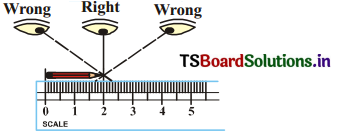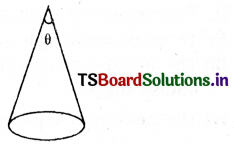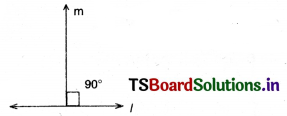Students can practice Telangana 6th Class Maths Textbook Solutions Chapter 5 Measures of Lines and Angles InText Questions to get the best methods of solving problems.
TS 6th Class Maths Solutions Chapter 5 Measures of Lines and Angles Exercise InText Questions
Think, Discuss and Write
Question 1.
How do we compare them ?
To compare them, we trace the line segments \(\overline{\mathrm{AB}}\) and \(\overline{\mathrm{CD}}\) on a tracing paper such that they are roughly aligned in the same direction. Do their end points coincide ?
Answer:
We can now say \(\overline{\mathrm{AB}}\) is longer than \(\overline{\mathrm{CD}}\). In the same way we can compare \(\overline{\mathrm{PQ}}\) with \(\overline{\mathrm{RS}}\). We can see \(\overline{\mathrm{PQ}}\) and \(\overline{\mathrm{RS}}\) are of equal length.
(Or)
We can compare the lengths of \(\overline{\mathrm{PQ}}\) and \(\overline{\mathrm{RS}}\) by a using a scale or a divider.
Now, we can say \(\overline{\mathrm{PQ}}\) > \(\overline{\mathrm{RS}}\)
∴ \(\overline{\mathrm{PQ}}\) = 3cm; \(\overline{\mathrm{RS}}\) = 25cm
∴ \(\overline{\mathrm{PQ}}\) > \(\overline{\mathrm{RS}}\)
![]()
Question 2.
What other errors can you find while measuring the length of line segment ?
For example, to find the length of a pencil, the eye Wrong Right Wrong should be correctly positioned as shown in the figure i.e., just vertically above the mark for both points. Other wise there may be an error due to angular viewing.

Answer:
(i) Eye error
(ii) Parallax error.
Try These
Question 1.
Take a post card and measure the length and breadth with ruler and divider. Do all post cards have the same dimensions ?
Answer:
By using ruler and a divider we can say that the dimensions of a post card are Length = 12 cm, Breadth = 7 cm
Same type of post cards are all having the same dimensions.
Question 2.
Select any three objects eraser, small pencil, etc. Trace their length on a paper. Measure the length of these line segments.
Answer:

The length of an eraser is 3 cm.
The length of a small pencil is 10 cms.
Try These
Question 1.
Use the right angle tester made of straw’s and identify the following angles.

Answer:
(i) Obtuse angle
(ii) Right angle
(iii) Acute angle
(iv) Obtuse angle
![]()
Question 2.
List out five daily life situations where you observe acute angles and obtuse angles
Answer:
Acute angles and obtuse angles are formed in following cases

- The angle between the slant slopes of buffoon cap.
- At the time of 2’o clock p.m. in a clock.
- At the time of 10’o clock.
- When the wrist is bonded.
- When the knee is bonded.
Question 3.
Draw some angles of your choice. Test them by the “angle tester” and write which are acute and which are obtuse and which are right angles.
Answer:

Think, Discuss and Write
In the adjacent figure ∠AOB and ∠AOC are given. Which angle is clock-wise and which angle is anti clock-wise. Think and discuss with your friends.

Answer:
∠AOB is formed in a clock-wise direction.
∠AOC is formed in an anti clock-wise direction.

Try These
Question 1.
Which angle is greater ? Discuss with your friends.

Verify by measuring the angles using protractor. Is your estimation is correct ? Give reasons.
Answer:
The measure of ∠1 = 30° and that of ∠2 = 30°
∴ Both the angles ∠1 and ∠2 are of equal measure.
![]()
Question 2.
Which are acute angles ? Find and write their measures.

Answer:
(i) The measure of angle in figure (i) is 30°. So it is an acute angle,
(ii) The measure of angle in figure (ii) is 50°. So it is an acute angle.
(iii) The measure of angle in figure (iii) is 130°. It is not an acute angle. Because it is an obtuse angle.
(iv) The measure of angle in figure (iv) is 90°. So it is a right angle.
(v) The measure of angle in figure (v) is 80°. So it is an acute angle.
Question 3.
Which are obtuse angles?

Answer:
(i) The measure of angle in figure (i) is 110°. So it is an obtuse angle.
(ii) The measure of angle in figure (ii) is 90°. So it is a right angle.
(iii) The measure of angle in figure (iii) is 130°. So it is an obtuse angle.
(iv) The measure of angle in figure (iv) is 50°. So it is an acute angle.
(v) The measure of angle in figure (v) is 325°. So it is a reflex angle.
Question 4.
Draw any two acute and two obtuse angles of your choice.
Answer:
Acute angles:

AOB and POQ are acute angles.
Obtuse angles:

XOY and MON are obtuse angles.
Question 5.
Classify the following angles into acute, right, obtuse and straight angles.
40°, 140°, 90°, 210°, 44°, 215°, 345°, 125°
10°, 120°, 89°, 270°, 30°, 115°, 180°
Answer:
Acute angles : 40°, 44°, 10°, 89°, 30°
Right angle : 90°
Obtuse angles : 140°, 125°, 120°, 115°
Straight angle : 180°
Reflex angles : 210°, 215°, 345°, 270°
![]()
Think, Discuss and Write
Question 1.
If l ⊥ m, then can we say that m ⊥ l?
Answer:
If l ⊥ m then m ⊥ l.
Since both l, m are perpendicular to each other.
Question 2.
How many perpendicular lines can be drawn to a given line ?
Answer:
We can draw only one line which is perpendicular to the given line.
Question 3.
Which letters in English alphabet possess perpendicularity ?
Answer:
L, T possess the perpendicularity.
Try These
Question 1.
Draw two lines on a paper as shown in the figure.
Do they intersect each other ?
Can you call them parallel lines ? Give reason.

Answer:
The above lines are not intersecting. If, they are extended on either sides they will intersect at a point. They are called intersecting lines i.e., they are not parallel lines.
Question 2.
Make a pair of parallel lines. What is the angle formed between them ? Think, discuss with your friends and teacher.
Answer:
The angle between the parallel lines is 0° (zero). Since they do not intersect.